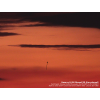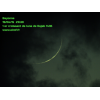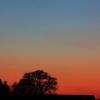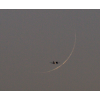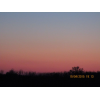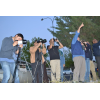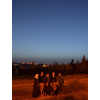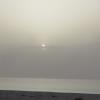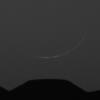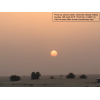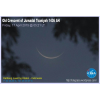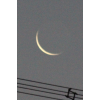Visibility of Rajab Crescent 1436 AH
- When to Observe Rajab Waxing (NEW) Crescent ?
- Rajab Waxing (NEW) Crescent Observation Results
- The OFFICIAL First Day in Different Countries
- When to Observe Jumadal Al-Aakherah Waning (OLD) Crescent ?
- Jumadal Al-Aakherah Waning (OLD) Crescent Observation Results
When to Observe Rajab Waxing (NEW) Crescent ?
The geocentric conjunction (Geocentric New Moon) will occur Inshalla on (Saturday 18 April 2015) at 18:57 UT.
Sighting the new crescent on (Saturday 18 April 2015) and (Sunday 19 April 2015) is shown in the below graphs using the program Accurate Times by Mohammad Odeh according to Odeh criterion. Where:-
- It is impossible to see the crescent from the areas located under the red color. Because either the Moon on this day sets before the Sunset and/or the topocentric conjunction occurs after the Sunset.
- The crescent is expected to be seen by optical aid only from the areas located under the blue color.
- The crescent is expected to be seen by optical aid from the areas located under the magenta color. In these areas the crescent could be seen by naked eye if the atmospheric conditions are superb and the observer is experienced.
- The crescent is expected to be easily visible by naked eye from the areas located under the green color.
- The crescent cannot be seen from uncolored areas, even though the Moon sets in these locations after the Sunset and the topocentric conjunction occurs before the Sunset, but the Moon is not sufficiently illuminated in order to be seen as crescent even by optical aid.
- Kindly notice that the below graph shows the possibility of seeing the crescent from areas between 60 degrees north of Equator down to 60 degrees south of Equator.
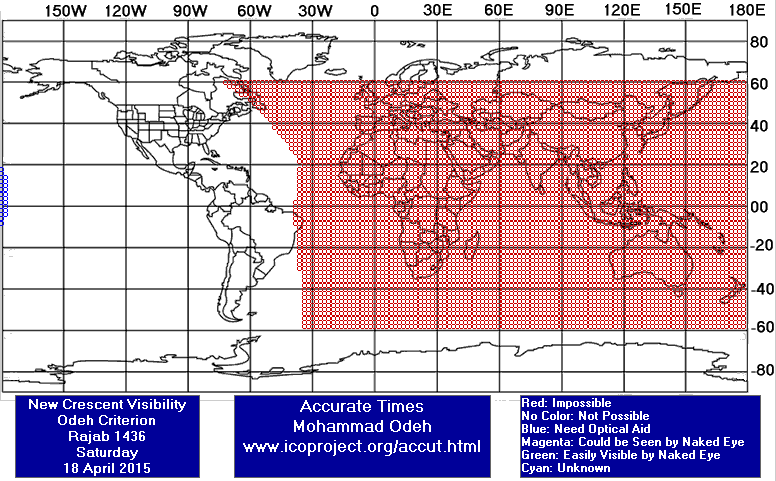

According to the Universal Hejric Calendar (UHC), which is based on the calculated crescent visibility, the start of this month in the Eastern Region will be on Monday 20 April 2015 and in the Western Region will be on Monday 20 April 2015. Kindly notice that the UHC is a pre-calculated calendar, which adopts a certain criterion to start the new Hejric month. Your country/organization might adopt different criterion to start the new Hejric month. So it is highly advised to read the UHC website before giving any judgment.
- Results of seeing the crescent, and the first day of the month in different countries will be added here Inshalla as we receive the reports from ICOP's members. If you wish to be a member in ICOP, or to know more about it, kindly click here.
Rajab Waxing (NEW) Crescent Observation Results
Sun 19 April 2015
Brunei Darussalam
Mr. Hazarry Haji Ali Ahmad said: "Alhamdullilah, a 15.5 hour old Hilal of Rejab 1436H was sighted this evening from Bukit Agok Hill, Tutong, Brunei Darssalam, by members of Astronomical Society of Brunei Darussalam. The western horizon was partly cloudy, the crescent was firstly visible when the altitude was 2 degrees, where the area of the sky was cloudless. Is was observed through the telescope then hardly seen to the naked eyes unless only through the finderscope. These are the images of the lunar crescent. It was super-thin. "
France
Mr. Farid Fofana said: "لمزيد من المعلومات و لمشاهدة التقارير الأخرى، يرجى زيارة موقع WWW.OLMF.FR"
Germany
Eng. Gerhard Ahmad Kaufmann said: "Today was a day with a very clear sky, nearly no clouds at all. Its transparency was also suported by a low relative humidity of only 30 %. About ten minutes after sunset, the very thin and crisp crescent could be seen first by binoculars at an altitude of 7°. The crescent was so thin that it had only an angular extension from the two o'clock to the six o'clock position. Me, my wife, my son and daughter could all see the crescent by binoculars. Twenty minutes later, I could spot the crescent also by naked eyes and follow it for ten more minutes until it sank below my local horizon at an altitude of 2.5°. Apart from the crescent observation, this was also a good opportunity for observation of the planets. I could easily observe all the planets Mercury, Venus, Mars, and Jupiter. Really a great show!"
Eng. Martin Elsaesser said: "I did a first observation of the young crescent in daytime before noon with the imaging system. This was easy enough at 8.8° elongation as the skies were fine. At sunset the weather was also fine and i could quickly see the crescent with binoculars and later also with the naked eye. There was a nice conjunction of the lunar crescent, bright mercury and fainter mars which was also nice to look at."
Ghana
Mr. Baba Abdulai said: "Date of sighting effort; Sunday 19TH April, 2015. The crescent was NOT seen in this location. I was at the sighting post from about 18:05 to about 19:04 but I did not see the crescent. The sky was slightly hazy with little or no clouds, per my observation. Moon age was about 23 hours at sunset local time in Tamale; with a moon lag time of about 55 minutes. Considering these two factors I find it quite surprising that I did not see the crescent. More surprising, crescent must have been quite close to the sunset position with a narrow azimuth angle (since the eclipse happened just a month ago), and I thought I knew just where to look out for the crescent. Yet I did not see it. And Allaah (SWT) Knows Best. Sighting community; Tampei-Kukuo Yepalsi, (near Bi-Water reservoir), Tamale."
Hungary
Indonesia
Mr. AR Sugeng Riyadi said: "On Sunday, 19 April 2015 we were the members of CASA (Club Astronomi Santri Assalaam) The Modern Boarding School of Islam ASSALAAM Kartasura Sukoharjo Central Java Indonesia tried to observe the new crescent of Rajab 1436 AH from several locations: 1. Denpasar Bali by mrs. Rossiana, not seen because cloudy. 2. Trenggalek East Java by mrs. Fatma Arum, not seen because cloudy. 3. Juwiring Klaten by Mr. AR Sugeng R, not seen because cloudy. 4. Yogyakarta by mr. Zaky, not seen because cloudy. 5. Kartasura by mr. Taufiq, not seen because rainy 6. Assalaam Observatory by CASA Team, not seen because cloudy. 7. Kudus by mr. Alis, not seen because cloudy. 8. Solo City by mr. Darmawan & mrs. Dwi Rahayu, not seen because rainy. 9. Jakarta by mrs. Utih, not seen because cloudy. 10. Bekasi by mrs. Ariffa, not seen because rainy. 11. Kebumen by mrs. Azifah, not seen because cloudy. My friend mr. Ma'rufin Effendy from LP2IF RHI Pekanbaru was repaorted that the new crescent of Rajab 1436 AH was SEEN from Tower of Baitul Jalal Mosque, East Labuhbaru Pekanbaru. The moon was seen 16 minutes after sunset only by telescope."
Iran
Mr. Hossein Janghorbani said: "In the name of God Rajab Crescent Observation Report Astronomy and Geophysics Center of Shahreza – The Crescent Association of Shahreza Report by: Hossein Janghorbani (Najm-al-Sepehr) – Manager of Shahreza Crescent Association and Red Crescent’s Astronomy and Geophysics Center Date: Sunday, 4/19/2015 Location: Mountain Shenly Dehaghan(Boodjan) in the Southwest of Shahreza (latitude: 31 50 N, longitude: 51 35 E, elevation: 2570m from sea level, time zone: +4.5 GMT) Equipments: two set of 15*70, one sets of 20*90 binoculars, one sets of 20*80 binoculars, one compass. Atmospheric condition: Hazy. Horizon obstacles: about 5° Apparent sunset: 19:09 Apparent Moonset:19:56 Results: Moon crescent was seen by 15*70 binoculars by Hossein Janghorbani at 19:35, for the first time. Other group members observed crescent by binoculars subsequently. Crescent observed by Fatemeh Hadad 19:43 by naked eye. Other group members observed crescent by naked eye The Fifth Festival on Jalali Hosseini NewRouz 14394 (Aries Solar) Held by Picking Traditional and Historic Table, Before Observing Observers : 1.Fatemeh sadat Mirtalaie 2.Miss.Kafash 3.Ashraf Rahmati 4.Parvaneh Hamidi 5.Sedigheh Fazeli 6.Iran Salesi 7.Zohre Karimpoor 8.Miss Malekian 9.Azam Erfan 10.Tayebeh Shafiee 11.Nazanin Piroozmandan 12.Zinat Ghermezi 13.Ziba Hafar 14.Masoomeh Hafar 15.Narjes Zare 16.Shahnaz Same 17.Mohammad Hosein Malekian 18.Elahe sadat Chavoshi 19.Benyamin Malekian 20.Hamid Nasirian 21.Mehr sadat Chavoshi 22.Sayed Hossein Chavoshi 23.Zahra Falahi 24.Narges Shahnazari 25.Hossein Janghorbani 26.Ali Janghorbani 27.Mohammad Javad Nikeghbal 28.Zahra Farokhpoor 29.Sayed Farzad Alavi 30.Atefeh Shokoohi 31.Zahra Sabzevari 32.Sayed Ali Sayedifar 33.Fatemeh Tanhaie 34.Sajad Rahimi 35.Melika Sayedifar 36.Mohadese Ghadiri 37.Parisa Haghighi 38.Fatemeh Hadad 39.Miss.Bagherpoor 40.Razyeh Tabibi 41.Molood Tabibi 42.Zahra Tabibi 43.Mheran Bahrami 43.Nazanin Heydari 44.Hadis Valikhani 45.Parinaz Derakhshan 46.Ghasem Yusefi 47.Mojtaba Ramezani 48.Tooba Ataie 49.Farzaneh Ataie 50.Soraya Ataie 51.Mahafarin Ataie 52.Roya Ghermezi 53.Roohallah Ghermezi 54.Zahra Parsania 55.Mahsa Khajeh 56.Solna Ataie 57.Roghayeh Karimi 58.Ensieh Javeri 59.Mahla Bahrami 60.Ali Tabibi 61.Fariba Soltani 62.Ali Reiesi 63.Somayeh Rezaie 64.Mr.Safari 65.Miss.Safari "
Iraq
Jordan
Ms. Basma Dhiab said: "Wow ! We were 13 members from the Jordanian Astronomical Society where we chose a nice location behind a public garden and a mosque (Al-Hussein's Gardens )to the west of Amman. We know from the hilal map that it could be seen at least by binocular. Yes, we were lucky since the sky was clear. Three of the participants " claimed" that they could see the crescent by their naked eyes, but they weren't sure. But, after a while, our friend Khaled Al tell saw it by the binocular ( 25*100 ) at 19:29. Then most of us could see it. And by his binocular ( 16*50,) Mohammad Reehan could see it too. What else? It was a good opportunity to take a nice shot with Venus too. Really it was a happy evening especially with the sweets and coffee prepared by our friend Ibraheem Odwan and his wife..:-)."
Libya
Eng. Mohammed Abdulkarim said: "إختفت الشمس خلف الضباب والغيوم قبل موعد غروبها الأصلي بنصف ساعة، ولذلك لم نتمكن رؤية الهلال بسبب كثافة الضباب والغيوم التي كانت تغطي الأفق، الصور المرفقة تم إلتقاطها أثتاء الرصد هذا اليوم... جمعية رؤية لهواة الفلك"
Nigeria
Dr. Z.Sani Mustapha said: "The star always present whenever the crescent appears is seen immediately after the maghrib prayer. The crescent not sighted. However this does not mean that it has not appeared. "
Mr. Qamarudeen Muhammad said: "The western sky was relatively clear of clouds yet I couldn't sight the new Hilal of Rajaab. Though the sky is a bit hazy. I think i equally blow one opportunity I could have had at seen the new hilal when I left the observation post for salat Magrib. By the time I come back out of the Masajid the altitude position of Hilal according to Stellarium is around than five degree above horizon. At this position the Sun had initially become obscured earlier. Moreover all these various location across Nigeria had similar experience of negative sighting. 1. Bauchi (Bauchi), 2. Ilorin, Kwara State 3. Sokoto, Sokoto 4. Kano, Kano State 5. Birni-Kebbi, Kebbi State 6. Abuja FCT 7. Abeokuta, Ijebu Ode, Otta-Owode, Ogun State 8. Lagos "
Oman
Prof. Mohammed Al-Bussaidi said: "For several days we are experiencing high dust levels and also hazy atmosphere. As such sighting of the crescent Moon by the telescope (eyepiece) was not possible. Sighting of the Rajab crescent Moon was possible by the use of camera attached to the telescope."
Saudi Arabia
Eng. Qamar Uddin said: "A grouup of us tried to sight the hilal of Rajab from Dammam today, Sunday 19/4/2015, but unable to do so as the sun disappeared well before sunset due to haze. Most of other places in Saudi Arabia also reported negative sightings."
Tanzania
Mr. Zaffar Sheriff said: "Local sunset in Daressalaam was 6.20pm. The crescent was confirmed at 6.38pm"
Mon 20 April 2015
Australia
Saudi Arabia
Eng. Qamar Uddin said: "Today, Monday 20/4/2015, the Rajab Hilal was easily seen on my way to the Maghrib prayer and the Masnoon duaa of Rajab Hilal was recited, Alhamdulillah. أَللّٰهُمَّ أَهِلَّهُ عَلَيْنَا بِالأَمْنِ وَالإِيـمَانِ وَالسَّلاَمَةِ وَالإِسْلاَمِ، رَبِّي وَرَبُّكَ اللّٰهُ . أَللّٰهُمَّ بَارِكْ لَنَا فِي رَجَبٍ وَشَعْبَانَ، وَبَلِّغْنَا شَهْرَ رَمَضَانَ،"
The OFFICIAL First Day in Different Countries
Mon 20 April 2015
1 . Brunei Darussalam
2 . Indonesia
3 . Iran
4 . Jordan
5 . Nigeria
6 . Oman
7 . Saudi Arabia
8 . Tanzania
Tue 21 April 2015
1 . Australia
When to Observe Jumadal Al-Aakherah Waning (OLD) Crescent ?
The geocentric conjunction (Geocentric New Moon) will occur Inshalla on (Saturday 18 April 2015) at 18:57 UT.
Sighting the OLD crescent on (Saturday 18 April 2015) and (Friday 17 April 2015) is shown in the below graphs using the program Accurate Times by Mohammad Odeh according to Odeh criterion. Where:-
- It is impossible to see the OLD crescent from the areas located under the red color. Because either the Moon on this day rises after the Sunrise and/or the topocentric conjunction occurs before the Sunrise.
- The crescent is expected to be seen by optical aid only from the areas located under the blue color.
- The crescent is expected to be seen by optical aid from the areas located under the magenta color. In these areas the crescent could be seen by naked eye if the atmospheric conditions are superb and the observer is experienced.
- The crescent is expected to be easily visible by naked eye from the areas located under the green color.
- The crescent cannot be seen from uncolored areas, even though the Moon rises in these locations before the Sunrise and the topocentric conjunction occurs after the Sunrise, but the Moon is not sufficiently illuminated in order to be seen as crescent even by optical aid.
- Kindly notice that the below graph shows the possibility of seeing the crescent from areas between 60 degrees north of Equator down to 60 degrees south of Equator.


Jumadal Al-Aakherah Waning (OLD) Crescent Observation Results
Fri 17 April 2015
Indonesia
Mr. AR Sugeng Riyadi said: "The old crescent of Jumadal Tsaniyah 1436 AH was easy SEEN on Friday, 17 April 2015 from my village Bendo Ketitang Juwiring Klaten Central Java Indonesia."
Nigeria
Dr. Z.Sani Mustapha said: "The moon was sighted yesterday 16/04/2015 from 5.15 to 6.15 a.m. Expected time of rising was 4.32 a.m. If the western horizon was clear the moon could have been sighted today 17/04/2015 around 5.20 a.m. "
Saudi Arabia
Dr. Ayyub Patel said: "Salams I couldnt report it on time due to problems. But here it is waning crescent for Jmadi II from abha seen 17 april in the morning Picture taking with canon 550d with 300x zoom setting on lense 55-300"
Eng. Qamar Uddin said: "I was expecting to easily see the waning crescent this moring before sunrise, but the eastern horizon was cloudy (see photo) so it wasn't seen."
Sat 18 April 2015
Libya
Eng. Mohamed Mogerby said: "قمنا بالرصد في يوم 19/04/2015 لأن يوم 18 كان الإقتران يحدث الساعة التاسعة ليلاً ولم نقم بالتحري في ذلك اليوم لأنه لا يرى ."

